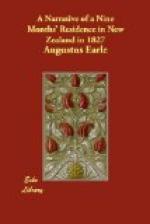In the midst of this wood we met the chief of this district, Patuone, who, together with all his family, were employed in planting a small, cleared patch of land. He appeared highly delighted at beholding strangers; and all his wives came from their occupations to welcome us. He told us that, a very few miles farther on, we should come to a village belonging to him, where his eldest son was residing, and that we must there pass the night.
[Illustration: Patuone, a Notable Hokianga Chief.]
We thanked him for the invitation, rubbed noses with him (their token of friendship), and parted.
Soon after parting with Patuone, we fell in with a most beautiful bull, cow, and calf. I was amazed at seeing such fine animals in this country; but my companions soon cleared up the mystery by informing me that they were gifts from the missionaries, who had orders from Home to distribute these useful animals amongst such chiefs as they thought would take care of them: a wise and beneficial measure. These animals were tabooed, consequently they could ramble wherever they found food most to their liking. About dusk we arrived at the village Patuone had described to us. We were most happy to see it, as we were heartily tired, and dripping wet from a recent and heavy shower.
CHAPTER VII.
A MAORI VILLAGE.
The village was situated on the side of a small, picturesque stream, one of the branches of the Hokianga, but continued droughts had at this time reduced it to a trifling brook. From its lofty banks, and the large trees lying athwart it, we conjectured that during heavy rains it must be a mighty flood. A long straggling collection of huts composed the village: a great deal of land in its vicinity was cleared and planted, which doubtless was the ostensible object of Patuone’s people being here. As the village lay upon the opposite shore from that on which we arrived, we sat some time under the shelter of a large tree, to contemplate its appearance, and to give time to arrange our party for passing the stream, and also for my making a sketch. The red glare of the setting sun, just touching the top of every object, beautifully illuminated the landscape; and its rays bursting through the black woods in the background, gave the woods an appearance of being on fire; while a beautiful rainbow, thrown across the sky, tinged the scene with a fairy-land effect.




